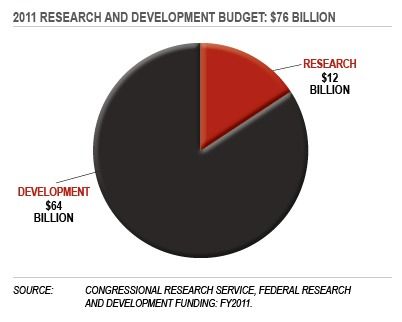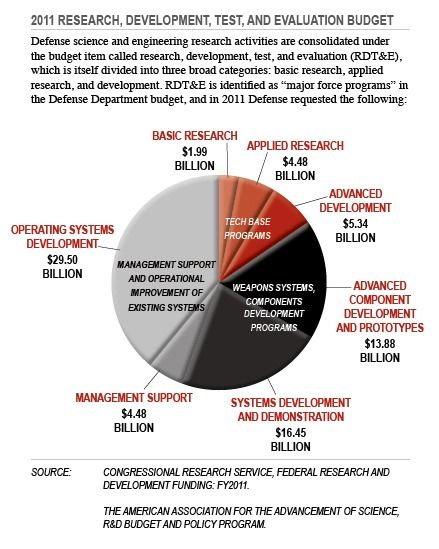Restructuring defense R&D
By Subrata Ghoshroy | December 20, 2011

In view of the United States’ massive budget deficits, there is growing, bipartisan recognition that the current level of defense spending — about $700 billion per year — is no longer sustainable. The Obama administration has made a variety of proposals to reduce the defense budget; cuts to big-ticket weapons programs like the F-22 or the F-35 Joint Strike Fighter are routinely mentioned. None of the defense-cutting proposals, however, seriously question the rationale and, more important, the structure of the American defense research and development (R&D) enterprise, which has grown wildly since it was established at the beginning of the Cold War.
There is irony here, and reason for reappraisal and restructuring. In 2011 the United States spent $76 billion annually on defense research and development, an amount that exceeds the total defense outlays — not just for R&D, but for all defense purposes — of every other country in the world except China. In the mid-1980s, as the Reagan administration pursued its Strategic Defense Initiative, the military R&D budget reached its previous high level of less than $70 billion in constant 2010 dollars. Now, two decades after the end of the Cold War, the US spends $6 billion more than that on R&D that often produces little of military or other value. Most of the US casualties in the wars in Iraq and Afghanistan have been caused by improvised explosive devices, which require little in the way of technology beyond the mobile phones used to detonate them. The United States’ high-technology, high-price, and high-maintenance weaponry is of relatively little value in such conflicts.
The military’s R&D budget has escaped detailed scrutiny largely because it is politically safe for members of Congress to support research — and politically dangerous not to. Any talk of cutting the R&D budget routinely results in push-back from the top universities and defense contractors, accompanied by a barrage of negative press coverage. No one, it seems, wants to be seen as opposing scientific research to bolster the “technological edge” that gave America its military superiority over the Soviet Union and continues to provide enormous advantages.
But much of what transpires in the name of military research and development is not research in the sense that it produces scientific and technical knowledge widely applicable inside and outside the Defense Department. A large part of defense R&D activity revolves around building very expensive gadgets that are often based on unsound technology and frequently fail to perform as required.
There is great room for reducing the overall military research and development budget — without harming military preparedness at all — by significantly overhauling its structure. Currently, the Pentagon spends only about 15 percent of its R&D budget, or about $12 billion, on what most reasonable observers might call productive research. That number needs to rise to at least $16 billion to meet the defense and civilian needs of the country.
Some $64 billion is spent on development activities — including prototype development and system demonstration — and should properly be included in the production phase of weapons program budgets, if they are pursued at all. Meanwhile, some $18 billion of the development budget goes toward classified programs that get relatively little oversight and are, therefore, prone to waste.
Moving these development and demonstration programs, including the classified ones, out of R&D and into defense procurement and production budgets will subject them to the scrutiny that weapons programs receive; as a result, many will die deserved deaths. (An example of the problem: When the $100 million test of a ground-based missile defense system failed in 1997, the contractors called it a “success” because there were no benchmarks. The missile defense program was then — and still is — in a research and development phase, and requirements could be waived without any hullabaloo.)
Such a refocusing of defense research and development efforts will save tens of billions of dollars each year — and do a great deal more. By directing more money to the relatively risky basic research that private corporations are loathe to undertake, these reforms will spur scientific innovation and lay the groundwork for the kinds of civilian adaptations that have long powered the American economy, from radar to the Internet.
The Pentagon’s R&D enterprise. To understand what is wrong with the defense R&D program, it helps to know a little about the Pentagon’s budgeting system and the alphabet soup of acronyms that it includes. Defense science and engineering research activities are divided into three broad categories: basic research, applied research, and development.
Basic research funding is intended to support “fundamental” scientific research that has ostensibly no connection to developing a specific weapon system. This category is the principal source of Pentagon’s largesse to universities. And whether the nation should continue to spend huge sums of money in defense R&D, especially at universities, is an issue worthy of debate.
Applied research funds go mostly to government laboratories and contractor facilities. The purpose of this spending is focused research that, unlike basic research, is usually not publicly disseminated.
Development is a catchall budget category that supports weapon-building and testing programs conducted largely by huge defense contractors such as Boeing, Lockheed, and Raytheon.

What’s wrong with structure of defense R&D? As the above graphic illustrates, the total for what is known as the tech base is about $12 billion, compared with approximately $64 billion for less research-oriented activities that receive little in the way of oversight.
One basic problem with this funding structure involves allocation of resources. Program managers do not have much incentive to stay in the research-oriented, tech-base area. Their promotion potential is directly related to the size of the programs they manage, and more funding is always available in the development budget categories. So pure research tends to lose its best managers to development.
Another problem is the use of the rubric “R&D” as cover for what actually are military procurement programs. One of the most egregious examples of such mislabeling is the missile defense program. Most R&D money for missile defense has been consumed in procuring hardware for deployment of largely unproven anti-missile systems at selected sites in the United States and abroad.
Were the missile defense program to be placed primarily in the procurement or production budget categories — an appropriate designation for the type of activities being undertaken — the program simply would not survive. It would fail the operational testing that would be a prerequisite before any deployment decision were made or paid for. The missile defense program costs nearly $10 billion a year and has so far produced little useful technology. Since inception, it has eaten up nearly $150 billion, almost all of it spent from the research and development budget. The boost-phase missile defense Airborne Laser program is a quintessential example of the broken research, development, test, and evaluation (RDT&E) enterprise.
The business of R&D. Congressional military committees have for years grossly abused the Defense R&D budget, using it to channel money to contractors in their districts via the earmarking process. In 2009, the Defense Department paid nearly $44 billion in R&D funds to its top 20 for-profit contractors, compared to $3.6 billion that went to nonprofit federally funded research and development centers, including research universities and the national laboratories they administer.
Over the years, R&D has become big business by minimizing research and spending wildly on almost anything that can be classified as development. In current dollars, the total US defense research and development budget has grown exponentially, expanding especially fast under the Ronald Reagan and George W. Bush administrations. The portion of the budget that is arguably for productive research has remained small.
- In 1978, the Defense Department spent $320 million for basic research out of a total R&D budget of about $13 billion, or roughly 2.5 percent for basic research.
- In 1984, it spent $845 million out of about $29 billion, or 2.9 percent.
- In 2006, it was $1.4 billion out of about $75 billion, or 1.86 percent.
The picture for science and technology research in the Pentagon does not improve much even if one takes into consideration the spending for applied research. While the Pentagon spends about 15 percent of the total R&D budget on basic and applied research, nearly 75 percent of the federal non-military R&D budget is spent on science and technology research.
The three R’s: Reduce the military R&D budget. Restructure priorities. Revitalize science. The overall US defense research and development budget can be reduced dramatically even as innovation and transparency are improved and again made hallmarks of a military research effort that has powered the American economy for much of the last century. To make such a change, however, the Obama administration and Congress must make the politically difficult decisions that separate research essentials from wasteful pork.
In the current financial situation, the overall defense budget will be cut, and there is no reason that tens of billions of dollars in spending reductions can’t come from RDT&E — if they are taken from the right places. These cuts should be realized in the development, demonstration, and support areas and in classified programs that, almost by definition, produce little in the way of scientific or technical advances that can be disseminated to the private sector. These overall budget cuts, however, should be combined with a paradigm shift in priorities that actually increases funding for research.
Even in these hard economic times, it is easy to justify restructuring the overall tech-base budget to $16 billion so that it prioritizes research: That is, doubling the basic research budget — to about $4 billion a year — and increasing applied research and advanced technology development by about 25 percent -– to about $12 billion.
First, the basic research budget has been essentially flat for decades, while the overall R&D budget has grown significantly. Second, the increased tech base budget will allow it more clout within the Defense Department, reducing incentives for program managers to leave tech-base research prematurely. It is not a trivial coincidence that most research in the tech base is done by nonprofit universities or federally funded research and development centers, while advanced development and engineering demonstrations in higher budget categories are the realm of for-profit contractors.
Third, moving advanced development and demonstrations from the research category into the production and procurement programs where they belong will put contractors under stricter oversight, increasing accountability and eliminating programs least likely to succeed.
Finally, and most important, a restructuring of defense research and development will spur innovation, directing more money to research of the kind that produces good science and useful technology that spurs economic growth. It is precisely this type of risky, basic research, which for-profit corporations increasingly do not pursue, that will produce the new and magical technology advances — the transistors and internets of the future — upon which America’s economic fortunes depend.
Reforming the defense R&D system will not be easy, because it requires challenging the interests of defense contractors that now profit handsomely from it. Those contractors raise a storm of protest and point to loss of jobs whenever their budgets are touched. And congressmen whose constituents work in the defense industry naturally listen to that protest, particularly because defense contractors are enduring sources of campaign contributions.
But a confluence of factors — massive budget deficits, a public debt that is about to exceed the nation’s gross domestic product, and an unprecedented global financial crisis — has for the first time in two decades forced lawmakers to seriously consider putting the defense budget on the chopping block.
Our universities and professional organizations of scientists and engineers frequently lament the decline of funding for basic research and the gradual loss of US dominance in science. In this budget environment, simply asking for more funds for science likely won’t bring results. A realistic program of R&D reform that helped the United States reassert its global leadership in science and technology and reduced the defense budget very well might.
No such reform can succeed without a simultaneous improvement in accountability and oversight of our defense programs. In-house scientific and technical capability has been eroded significantly over the years, which has resulted in the government outsourcing critical program decisions to contractors. This situation must change before the quality of science and technology in defense R&D can improve. But such change will take time. Meanwhile, the budgetary reforms proposed here will go a long way to reduce enormous waste of taxpayer dollars and help restore some integrity to the process.
Together, we make the world safer.
The Bulletin elevates expert voices above the noise. But as an independent nonprofit organization, our operations depend on the support of readers like you. Help us continue to deliver quality journalism that holds leaders accountable. Your support of our work at any level is important. In return, we promise our coverage will be understandable, influential, vigilant, solution-oriented, and fair-minded. Together we can make a difference.
Topics: Nuclear Weapons, Opinion















